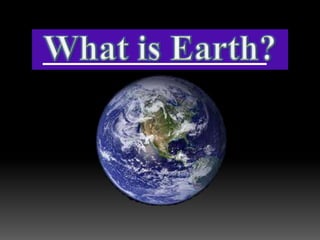Introduction about Earth
•Download as PPTX, PDF•
0 likes•99 views
In this presentation, i am study about the earth which includes introduction of earth, anatomy of earth and so more for you
Report
Share
Report
Share

Recommended
More Related Content
Similar to Introduction about Earth
Similar to Introduction about Earth (20)
Is ground solid enough to stand on. Authors: Virginia Evans, Ksenia Baranova/...

Is ground solid enough to stand on. Authors: Virginia Evans, Ksenia Baranova/...
07: Earth’S Interior Austin Connor Mitchell Adrain

07: Earth’S Interior Austin Connor Mitchell Adrain
Recently uploaded
Antibiotics are medicines that fight infections caused by bacteria in humans and animals by either killing the bacteria or making it difficult for the bacteria to grow and multiply. Bacteria are germsABHISHEK ANTIBIOTICS PPT MICROBIOLOGY // USES OF ANTIOBIOTICS TYPES OF ANTIB...

ABHISHEK ANTIBIOTICS PPT MICROBIOLOGY // USES OF ANTIOBIOTICS TYPES OF ANTIB...ABHISHEK SONI NIMT INSTITUTE OF MEDICAL AND PARAMEDCIAL SCIENCES , GOVT PG COLLEGE NOIDA
Recently uploaded (20)
development of diagnostic enzyme assay to detect leuser virus

development of diagnostic enzyme assay to detect leuser virus
Molecular phylogeny, molecular clock hypothesis, molecular evolution, kimuras...

Molecular phylogeny, molecular clock hypothesis, molecular evolution, kimuras...
Understanding Partial Differential Equations: Types and Solution Methods

Understanding Partial Differential Equations: Types and Solution Methods
COMPOSTING : types of compost, merits and demerits

COMPOSTING : types of compost, merits and demerits
FAIRSpectra - Enabling the FAIRification of Analytical Science

FAIRSpectra - Enabling the FAIRification of Analytical Science
Thyroid Physiology_Dr.E. Muralinath_ Associate Professor

Thyroid Physiology_Dr.E. Muralinath_ Associate Professor
X-rays from a Central “Exhaust Vent” of the Galactic Center Chimney

X-rays from a Central “Exhaust Vent” of the Galactic Center Chimney
TransientOffsetin14CAftertheCarringtonEventRecordedbyPolarTreeRings

TransientOffsetin14CAftertheCarringtonEventRecordedbyPolarTreeRings
GBSN - Biochemistry (Unit 2) Basic concept of organic chemistry 

GBSN - Biochemistry (Unit 2) Basic concept of organic chemistry
Cyathodium bryophyte: morphology, anatomy, reproduction etc.

Cyathodium bryophyte: morphology, anatomy, reproduction etc.
ABHISHEK ANTIBIOTICS PPT MICROBIOLOGY // USES OF ANTIOBIOTICS TYPES OF ANTIB...

ABHISHEK ANTIBIOTICS PPT MICROBIOLOGY // USES OF ANTIOBIOTICS TYPES OF ANTIB...
Efficient spin-up of Earth System Models usingsequence acceleration

Efficient spin-up of Earth System Models usingsequence acceleration
Introduction about Earth
- 2. Earth The planet on which we live is called EARTH. It travel around the Sun, along with other planets in our Solar System The planet Earth is located in one of the spiral arms ( the Orion arms ) of the Milky way, a large spiral galaxy. The Earth is a rocky, terrestrial planet, that has a surface covered with mountains, valleys, carryon's and so much more. What is special about our planet is that water is covering 71% of it surface
- 3. The structure of the earth is divided into four major Components: the crust, the mantle, the outer core, and the inner core. Each layer has a unique chemical composition, physical state, and can impact life on Earth's surface.
- 4. The crust is the thinnest layer of the Earth. It has an average thickness of about 18 miles (30km) below land, and around 6 miles (10km) below the oceans. The crust is the layer that makes up the Earth's surface
- 5. The mantle is the mostly solid bulk of Earth's interior. The mantle lies between Earth's dense, superheated core and its thin outer layer, the crust. The mantle is about 2,900 kilometers (1,802 miles) thick, and makes up a whopping 84 percent of Earth's total volume. There are two major component of mantle upper mantle, inner mantle
- 6. Upper mantle: The upper mantle extends from the crust to a depth of about 410 kilometers (255 miles). The upper mantle is mostly solid, but its more malleable regions contribute to tectonic activity. Two parts of the upper mantle are often recognized as distinct regions in Earth's interior: the lithosphere and the asthenosphere.
- 7. Inner mantle: The mantle is the mostly solid bulk of Earth's interior. The mantle lies between Earth's dense, super-heated core and its thin outer layer, the crust. The mantle is about , and makes up a whopping of Earth's total volume.
- 8. The mantle is the mostly solid bulk of Earth's interior. The mantle lies between Earth's dense, superheated core and its thin outer layer, the crust. The mantle is about 2,900 kilometers (1,802 miles) thick, and makes up a whopping 84 percent of Earth's total volume.
- 9. The innermost part of Earth is the core and is about 1500 miles (2414 km) thick. Both the inner and outer cores consist primarily of iron and nickel. They're extremely hot, with temperatures ranging from 7200– 9000℉